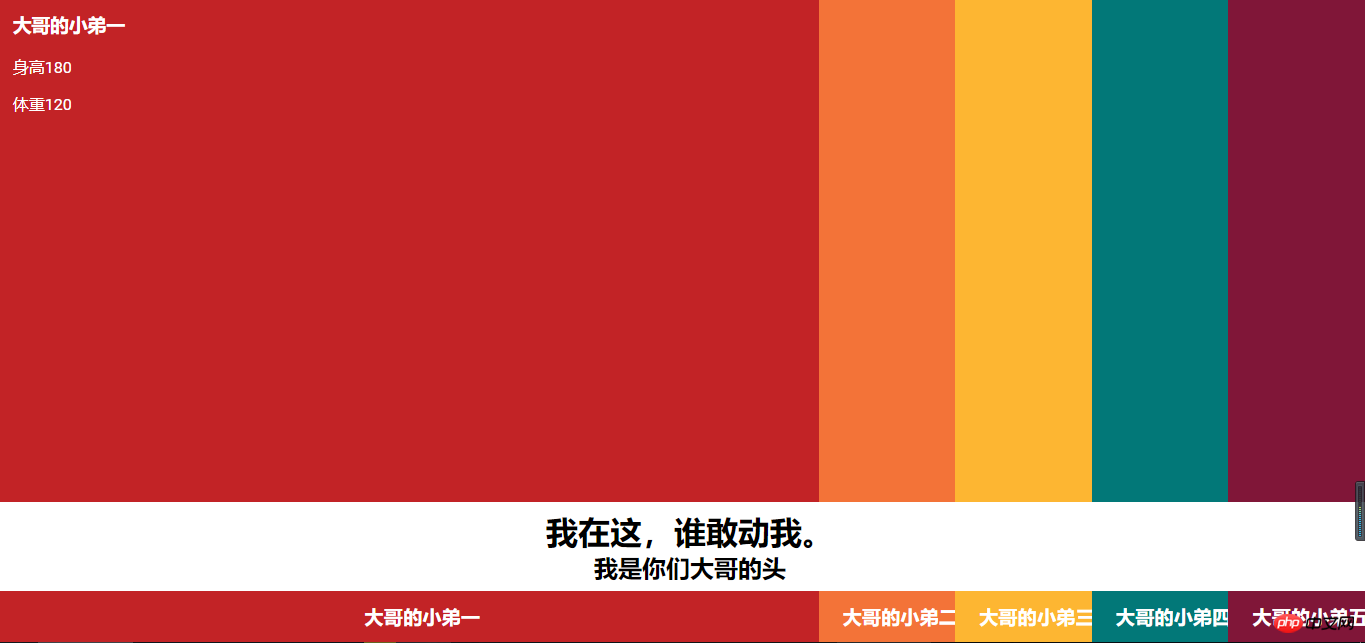
Dieses Mal werde ich Ihnen CSS und Medienabfragen zur Implementierung der Webnavigationsfunktion (mit Code) vorstellen. Was sind die Vorsichtsmaßnahmen für die Implementierung der Webnavigationsfunktion mit CSS und Medien? Hier sind die praktischen Fälle.
Im Anhang finden Sie das Rendering. Wenn Sie sich wohl fühlen, lesen Sie bitte den Implementierungscode:

Der Code lautet wie folgt, kopieren Sie ihn und verwenden Sie ihn:
<!DOCTYPE html>
<html lang="en">
<head>
<meta charset="UTF-8">
<title>Document</title>
<style>
body {
background: #801638;
}
body,
body > * {
margin: 0;
padding: 0;
font-family: 'Roboto', sans-serif;
font-weight: normal;
}
* {
transition: all .3s ease 0s;
}
/* Background colours */
p + p article:nth-child(1) {
background: #c22326;
}
p + p article:nth-child(2) {
background: #f37338;
}
p + p article:nth-child(3) {
background: #fdb632;
}
p + p article:nth-child(4) {
background: #027878;
}
p + p article:nth-child(5),
p + p {
background: #801638;
}
/* Main layout */
html,
body,
p + p {
width: 100vw;
height: 100vh;
}
p + p {
list-style: none;
position: relative;
display: flex;
flex-direction: row;
flex-wrap: nowrap;
align-items: stretch;
overflow: hidden;
}
/* Articles */
p + p article {
flex: initial;
width: 20%;
height: 100%;
text-align: center;
color: #fff;
text-decoration: none;
vertical-align: bottom;
box-sizing: border-box;
padding: 2vh 1vw;
position: relative;
}
/* Big Headings */
body > p:first-child {
position: fixed;
bottom: 8vh;
background: #fff;
width: 100%;
text-align: center;
padding: .5rem;
z-index: 2;
}
body > p:first-child h1,
body > p:first-child h2 {
margin: 0;
padding: 0;
}
/* Hover interaction */
p + p:hover article {
flex: initial;
width: 10%;
}
p + p article:hover {
width: 60%;
}
article > p {
opacity: 0;
transition: opacity .2s ease 0;
}
p + p article:hover > p {
opacity: 1;
transition: opacity .3s ease .3s;
}
/* navigation */
p + p article > h2 {
bottom: 2vh;
position: absolute;
text-align: center;
width: 100%;
margin: 0;
font-size: 3vh;
}
/* Article layouts */
article p {
text-align: left;
width: 58vw;
}
article p p,
article p p h2,
article p h3 {
margin: 0 0 1em 0;
}
article p p {
width: 40vw;
}
@media (max-width: 900px) {
p + p article {
padding: 2vh 3vw;
}
p + p article > h2 {
transform: rotate(90deg);
bottom: 23vh;
min-width: 12em;
text-align: left;
transform: rotate(-90deg);
transform-origin: 0 0 0;
opacity: 1;
}
p + p article:hover > h2 {
opacity: 0;
}
article p p {
width: 50vw;
}
article p {
max-height: calc(72%);
overflow-y: auto;
}
}
</style>
</head>
<body>
<p>
<h1>我在这,谁敢动我。</h1>
<h2>我是你们大哥的头</h2>
</p>
<p>
<article>
<h2>大哥的小弟一</h2>
<p>
<h3>大哥的小弟一</h3>
<p>身高180</p>
<p>体重120</p>
</p>
</article>
<article>
<h2>大哥的小弟二</h2>
<p>
<h3>大哥的小弟二</h3>
<p>身高160</p>
<p>体重100</p>
</p>
</article>
<article>
<h2>大哥的小弟三</h2>
<p>
<h3>大哥的小弟三</h3>
<p>身高175</p>
<p>体重180</p>
</p>
</article>
<article>
<h2>大哥的小弟四</h2>
<p>
<h3>大哥的小弟四</h3>
<p>身高180</p>
<p>体重110</p>
</p>
</article>
<article>
<h2>大哥的小弟五</h2>
<p>
<h3>大哥的小弟五</h3>
<p>身高180</p>
<p>体重150</p>
</p>
</article>
</p>
</body>
</html>Ich glaube, dass Sie die Methode beherrschen, nachdem Sie den Fall in diesem Artikel gelesen haben. Weitere spannende Informationen finden Sie in anderen verwandten Artikeln auf der chinesischen PHP-Website!
Empfohlene Lektüre:
Detaillierte Erläuterung der Verwendung des Node-Debugging-Tools
Detaillierte Erläuterung der Schritte der Webpack-Verpackung und Komprimierung von js und css
Das obige ist der detaillierte Inhalt vonCSS- und Medienabfragen implementieren die Webnavigationsfunktion (mit Code). Für weitere Informationen folgen Sie bitte anderen verwandten Artikeln auf der PHP chinesischen Website!




